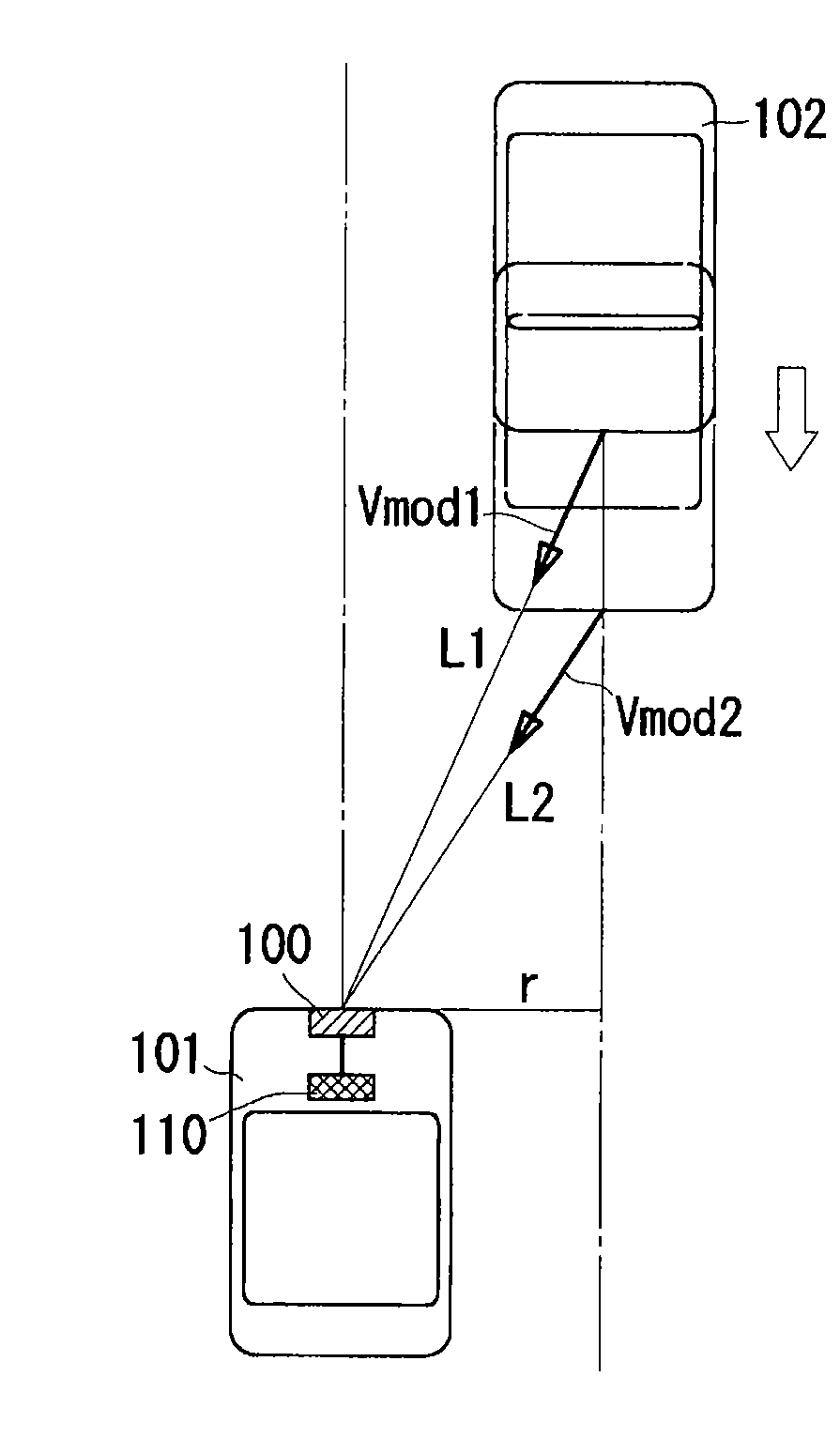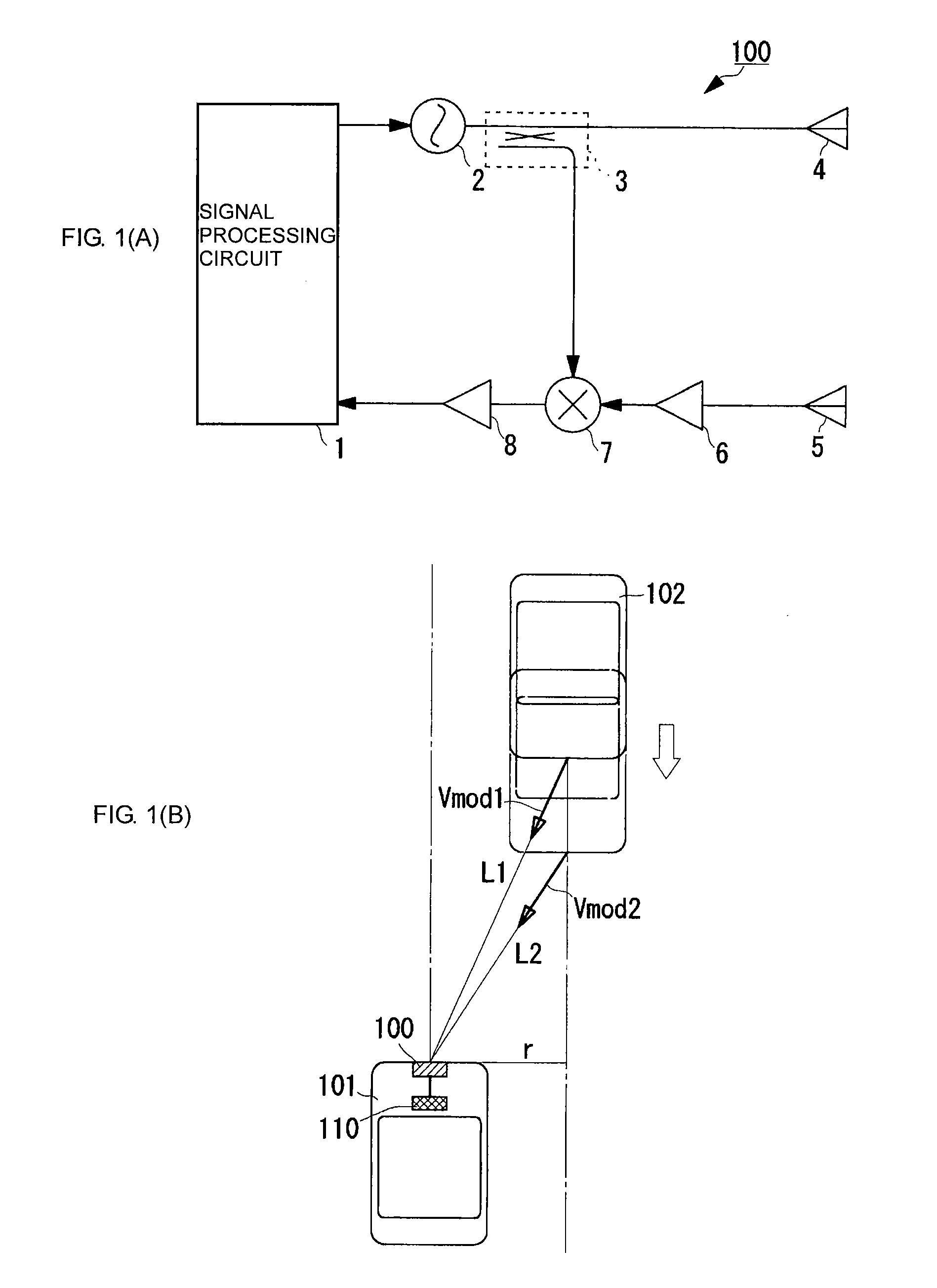Radar Apparatus and Mobile Object
- Summary
- Abstract
- Description
- Claims
- Application Information
AI Technical Summary
Benefits of technology
Problems solved by technology
Method used
Image
Examples
first embodiment
[0088]A radar apparatus according to a first embodiment of the present invention is described with reference to the accompanying drawings. In this embodiment, a radar apparatus that employs an FMCW method using a transmission signal frequency-modulated in a triangular waveform is described as an example.
[0089]FIG. 1(A) is a block diagram of a main configuration of the radar apparatus according to the first embodiment. FIG. 1(B) illustrates a concept of a method for computing a distance of closest approach of an oncoming vehicle 102 to a vehicle 101 including a radar apparatus 100 mounted therein. Note that, in FIG. 1(B), the vehicle 101 is stationary. However, FIG. 1(B) illustrates a simplified situation for ease of description. In this example, the oncoming vehicle 102 is a detection object, and the vehicle 101 and the oncoming vehicle 102 are located in the same horizontal plane (i.e., the height of the oncoming vehicle 102 relative to the vehicle 101 is 0). Even when the vehicle ...
second embodiment
[0111]A radar apparatus according to a second embodiment is described next. According to the present embodiment, the radar apparatus has a configuration the same as that of the first embodiment. For example, the radar apparatus transmits pulses of electromagnetic waves or light and measures a distance on the basis of a time when the pulses reflected by an object is returned to the radar apparatus.
[0112]Such a radar apparatus cannot compute the above-described radar-apparatus-direction relative velocity Vmod. However, the radar apparatus can compute the distance L. In this case, for example, a predetermined short time interval Δt is set. By using a distance L11 at a beginning time point of the short time interval Δt and a distance L12 at an end time point of the short time interval Δt, the radar-apparatus-direction relative velocity Vmod1 can be computed using the following equation (13):
V mod1=(L11−L12) / Δt (13)
[0113]In such a manner, by computing the radar-apparatus-direction relat...
third embodiment
[0114]A radar apparatus according to a third embodiment is described next. According to the present embodiment, the radar apparatus has a configuration in which the reception antenna 5 can perform a scanning operation in a predetermined direction of the detection area. The other configurations are similar to those of the radar apparatus of the first embodiment.
[0115]The reception antenna 5 includes a plurality of antennas along an azimuth direction (a horizontal direction in this case). The reception antenna 5 further includes a switch for sequentially switching the antennas. Alternatively, the reception antenna 5 includes a mechanism for scanning one antenna in the azimuth direction.
[0116]In such a configuration, detection signals sequentially input to the signal processing circuit 1 are time-series signals obtained from different azimuth directions. The signal processing circuit 1 sequentially acquires a detection signal for one scan cycle and stores the acquired detection signal ...
PUM
 Login to View More
Login to View More Abstract
Description
Claims
Application Information
 Login to View More
Login to View More - R&D
- Intellectual Property
- Life Sciences
- Materials
- Tech Scout
- Unparalleled Data Quality
- Higher Quality Content
- 60% Fewer Hallucinations
Browse by: Latest US Patents, China's latest patents, Technical Efficacy Thesaurus, Application Domain, Technology Topic, Popular Technical Reports.
© 2025 PatSnap. All rights reserved.Legal|Privacy policy|Modern Slavery Act Transparency Statement|Sitemap|About US| Contact US: help@patsnap.com



